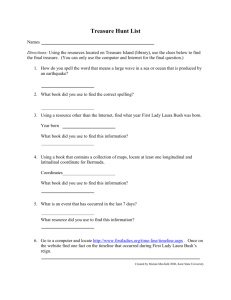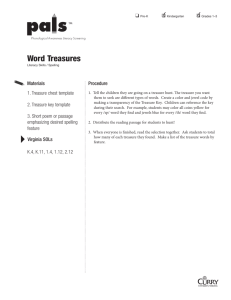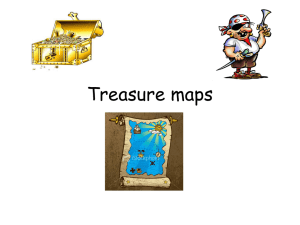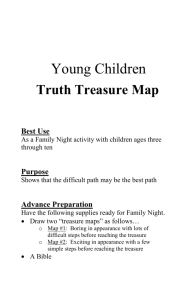Introduction1134
advertisement
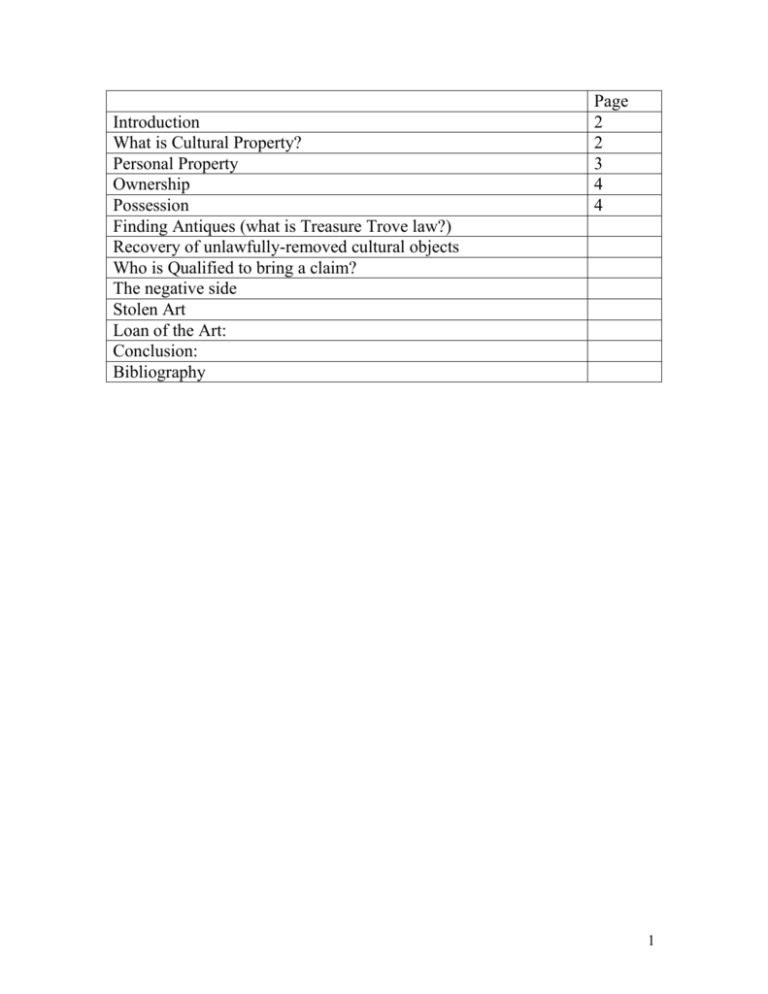
Introduction What is Cultural Property? Personal Property Ownership Possession Finding Antiques (what is Treasure Trove law?) Recovery of unlawfully-removed cultural objects Who is Qualified to bring a claim? The negative side Stolen Art Loan of the Art: Conclusion: Bibliography Page 2 2 3 4 4 1 Introduction: One of the most important in the 20th century is protection of culture property or in other word, protection of cultural object. These cultural objects are taken from their country of origin by thefts or the smugglers of cultural property, some of this object has been returned to their country of origin, “in Response to popular demand, international pressure.”1 Under Islamic law, ownership belongs to god and is held as trust by man but on the contrary, under England and Walse law the ownership can belongs to individuals and states that have got possession. England law has not defined the cultural property except treasure. People have been living in the UK for many years many thousands quantity of tools and other things (Cultural property object) have been lost or throw away during this period. Hence, still large quantities can be found in the soil or even on the land. People are coming from every where especially from USA, with metal detectors to find to these items. For many years, many items and even antique item are being sold in the auction house which some of them are “cultural property”. As a consequence, many issues arise, in one hand, archeologist wants to protect all of these items and keep them in Galleries or Museums, in other hand; government does not want to protect and keep these item. The other important issue is, museum are being loaning their items to provide a complete picture of artist work. Loan agreement must be carefully written for parties to ensure the safety and security of art. However sometimes borrower wants to keep the collection or someone comes and claim the arts work in the jurisdiction. 1 The law and ethics Deriving from the Parthenon marbles case. Irini A. stamatordi 2 Cultural property and Law reflects the vast range of human activity in the field. Much of human activity is commercial and deals with art (cultural property) as personal property. Cases on the sale or lease of art works, transport and insurance, title disputes, limitation periods, cross-border theft and finding the art and even packaging, shows England laws deal with them as personal property. What is Cultural Property? Property meant that the object owned and cultural is an adjective which refers to the nature of the object. Cultural property “ Defined as object that are an “ expression and testimony of human creativity and are “ of archeological , historical , artistic , scientific , are technical value or interest”2 Personal Property R.G . Hammond to answer this question , what property is , states : “ By characterizing a person’s interest as “ proprietary “ We lawyers are indicating the existence at certain rights in relation to some thing , which maybe tangible or intangible , which must be respected by all other person3 Everyone is families with personal property. Everyone buys, owns, and borrows thing. The personal property of law defines how to deal with personal property law. In the common law system personal property is called “chattels.” Property law has some principles, policies deal with relationships between and among members at a society with respect to things.4 In order to obtain title to a chattel from person who does not own it, the transfer must have had possession, and also the transfer must have been in good faith5. In the civil law systems personal property is often called movable property or movables, any property that can be moved from one location or another. Personal property may be classified in a variety of ways, such as goods, money, negotiable instruments. 2 Recommendation for the protection of Movable Cultural Property , UNESCO , 1978 , section 1, www.city.ac.uk/artspol and “Property, Culture, and Cultural Property, Dusan Pokorny 3 Personal Property , commentary and materials , K.G. Hammond , Oxford University press 1992 4 Encyclopedia of Britannica. 2005. 5 Encyclopedia, Britannia. 3 Common law distinguishes between “real property” and “personal property”. In fact, property is a relationship between who has got the things. The concept of the personal property is ownership, possession and title6. Ownership: Honore defines ownership as “the greatest possible interest in a thing which a mature legal system recognizes.”7Then, he discuss about some right of the ownership as “ The right to possess the right to use, the right to manage the right to the income of the things. Possession: Certain person who have physical control of a thing are hold to possess if he has the rights of ownership. In the case united states of Amenica V. pollfus mieg , judge Earl Jowitt stated that English law had never worked out a completely logical and exhaustive definition of possession 8 Like every jurisdiction, chattel may be possessed before they come into existence for after they have perches9 Finding Antiques (what is Treasure Trove law?) The current law of Treasure Trove in England and Wales would seem to have come originally from the principle that all ownerless objects should belong to the King. In England the law of Treasure Trove has developed . The law first became modified in 12th and 13th centuries AD and the description of Treasure Trove in Henry de Bracton's De legibus et consuetudinibus Angliae (c.1250) . In England and Wales Treasure Trove is limited to objects of precious metal buried with intention of recovery. It is the first two elements that cause most difficulty today. Treasure Trove only extends to objects that have been buried with intention of recovery rather than being lost or abandoned or placed in a grave, because the origin of the law was to discourage people from trying to avoid tax by concealing their wealth, but this is probably to put a modern construction on the evolution of a law under which all ownerless objects originally belonged to the Crown. 6 Personal property law, Text and material. Sarah Worthington . Oxford ,2000. A M Honore, ownership in A G Guest, Oxford essays in jurisprudence C1918. Oxford, page 107. 8 United states of America V. Dollfus mieg et CIE SA [M52] AC 582 9 Personal property law, professor M.G Bridge Oxford, 2002 . page 16 7 4 The Treasure Act 1996 came into force on 24th September 1997 in England, Wales. Under Treasure Act 1996, any treasure found, wherever, vests, subject to prior interests and rights in the franchisee, if there is one otherwise, in the Crown. 10 Treasure is defined as : Objects other than coins :Any object other than a coin provided that it contains at least 10 per cent of gold or silver and is at least 300 years old when found. Coins: “Coin" includes any metal token which was, or can reasonably be assumed to have been, used or intended for use as or instead of money.”11 All coins from the same find provided they are at least 300 years old when found. Single coins found on their own are not treasure and groups of coins lost one by one over a period of time will not normally be treasure. Associated objects: Any object, whatever it is made of, that is found in the same place as, or that had previously been together with, another object that is treasure. 12 Recovery of unlawfully-removed cultural objects13 Unlawful Removal is a new phenomenon which it is not confined to ‘theft’ in the narrow popular sense of a direct taking from the possession of private individuals and institutions without their consent. Even if a wrongful removal is established, the physical return of the object to its claimant Owner is only one option available at law and is generally at the court’s discretion. However , when it comes to defining the conditions under which a “ displaced “ cultural object ought to be returned to “ where it belongs ,“ the existing international conversation manifestly place the interest of the present holder before that of that claimant invoking an original title to the artifact. True, all cultural objects that were stolen – that is, unlawfully Treasure Act 1996, Section 4 : “Ownership of treasure: When treasure is found, it vests, subject to prior interests and rights : (a) in the franchisee, if there is one, (b) otherwise, in the Crown. 11 Ibid, Section 3 12 Treasure Act 1996, Section 1 : “Treasure is- any object at least 300 years old when found which (i) is not a coin but has metallic content of which at least 10 per cent by weight is precious metal when found, is one of at least two coins in the same find which are at least 300 years old at that time and have that percentage of precious metal; or iii) when found, is one of at least ten coins in the same find which are at least 300 years old at that time.” 13 RECOVERY OF UNLAWFULLY-REMOVED WORKS OF ART AND ANTIQUITY - THE LEGAL DIMENSION -Norman Palmer 10 5 excavated or unlawfully retained – must be returned, subject to compensation to an innocent possessor. Cultural objects that were illegally exported also have to be returned, if one of the following conditions is satisfied : restoration is necessary for the physical preservation of the object or for the integrity of a complex object; the aircraft was used in rituals of a traditional or indigenous community; the object contain significant information from a historical or scientific point of view; it can be shown that it is of “ significant cultural importance “ for the requesting state. But all these provisions apply only if the cultural object was stolen or illegally exported after 1995: they have no retroactive effect. Who is Qualified to bring a claim The normal cause of action for a wrongfully-removed chattel is the common law action or claim for conversion. To sue in conversion a person need show only that she had either possession, or the immediate right to possession, of the chattel at the time the wrongful act was committed. It is not necessary to prove full ownership, although most claimants in conversion are in fact the owners. A museum holding a picture on loan from the owner, for example, could sue for conversion if the work were stolen and bought by a third party who refused to return it. Claims to cultural objects (by individuals, cultural institutions, municipalities and states) can and do succeed through reliance on the general law. Recent examples in England are Madame de Preval’s claim for the return of her Barye candlesticks (1997) and the City of Gotha’s claim to the painting ‘Holy Family’ by Joachim Wtewael (1998). The negative side Claimants face numerous legal hazards, including the expiry of the relevant limitation period and the operation of the lex situs rule, by which an overseas disposal of personal property contrary to the rights of the original owner is regarded by the courts of this country as effective to confer title on a good faith acquirer (and to extinguish the rights of the original owner) if that is the effect given to it by the law of the country where the chattel was situated at the time (see Winkworth v Christie Manson & Woods, 1980). The law is not in a satisfactory condition and its use can be particularly distressing for 6 elderly victims of mass injustice, such as Holocaust victims, or even survivors of the Bolshevik confiscations (like Madame Shchukina, who unsuccessfully sued the Pompidou Centre at Paris for the return of some Matisse paintings seven years ago) STOLEN ART: One of the problems is concern to all who transact the art. What is the position, where the subject of the art transaction is stolen? In fact both parties (seller and buyer or lender and borrows) are innocent. the theft remains two victims( buyer and seller) and the court try to balance their rights. English law has principle which “ nemo dat qui non hobet” : no one can give a better title than he has : in other word :” a person who does not give good title to the person to whom he purports to sell that chattel”14. This principals come to the Sale of goods Act, section 21(1): ‘subject to this Act, where goods are sold by a person who is not their owner, and who does not sell them under the authority or with the consent of the owner , The buyer acquires no better title to the goods than the seller had, unless the owner of the goods is by conduct preclude from doing the sellers authoring to sell”15 therefore, under sale of goods Act the real owner of stolen art may bring an action to recover the goods or their value from the innocent buyer who may try to recover his loss from the theft16therefore, under Torts Act 1997, provides various forms of relief which a court may use to proceed for wrongful interference with goods, against a person who is buyer. The direction of institute of Art and law, said: “conversion is committed when ever one person performs a positive wrongful act of dealing with goods in a manner inconsistent with the rights of the owner.’17 Detective chief inspector Charles Hill said: chargers of dishonest shipping fail at court when dealing with those arrested in possession of stolen cultural 14 -Recovering stolen AT: The civil law. Ruth readmond – Cooper. Institute of ART and law. 15 The sale of goods ACT s.21(1) 16 Jerome V.Bentley[ 2 all E.R. 114]. Moorgate mercantile Co. LTD. v Twitchings [1997] A.C.890 17 Director, institute of Art and law, Honorary lecture, university collage Swansea. 7 property. It times to try another track!18He suggested to use money laundering legislation. Sales of the art: Seller of a chattel must ensure that the description which he told to buyers condition of contract and seller responsibility is strict, the buyer may discover the fault , may be cancels the contract or recover damager to represent his loss. In case” Harly don and Leinster” the court of appeal; held that, the seller did not describe carefully what he sold and the pictures when he sold was fake. Therefore seller may be used for misrepresentation by buyer.19 Nowadays, some cases arise which has the basic common law liability of professional art carrier.20The liability has been defined by comprehensive contract terms.” With the futher gloss (in cross- border cases) on the International conventions. There are numerous factors which many disable unfair terms. Under unfair Contract terms Act 1977 or the unfair terms in consumer contract regulator, some of These terms and conditions are invalid. A recent case which can show some harsh and in reasonable conditions is “ Lacey’s foot wear( wholesale)LTD.V.Rowler International LTD[1997]2 liyod’s kep 369. Two kinds of carriers are subject of the law: a) common carries and b) private carriers) they define a (private or public) career undertaking to carry of the gods. The carriers are responsible to take care of the goods while they are in possession. The measure of care is depending on the circumstances and conditions of the goods.21 Loan of the Art: On of the form possessor relationship is that lender and borrowers. Borrower like a huge is not responsible until the good is delivered. However, if the 18 .The Role of the police : To find and use better ways to recovers stolen property, detective chief Inspector Charles Hill, metropolitan police. 19 Section 2(1) misrepresentation ACT 1967:’ Where a person has entered in to a contract after a misrepresentation has been made to him by another party thereto and as a result thereof he has leaf V International Galleries [1950] 2 KB 88 20 . legal aspect of the movement of Art and Antiquities, sale, loan and pledge, Norman Palmer. 21 Mason V morrow’s moving and storage Ltd [1978] 2 WWR 534(BC CA) 8 Borrower is a hirer, he can sue the lender before he possesses the goods if damage occurs because of his interest.22 John Murdoch believed: “the power of decision is devolved to the director of the museum.”23 The first step, museums must be ensuring who is the owner of art which want to be lent. The lack of detailed documentation in past, means the museum can not be sure of who has the ownership of an item. If museum lend an object, it can be claimed by the true owner in the jurisdiction. UK has a specific legislation to protect museums. Under section 3 of the limitation Act 1980, if the owner of art did not sue the museum within 6 years, title could be considered to have passed to the borrowing museum. English law like other jurisdiction is subject to certain time limits for proceeding which is after a period of time no action generally is possible.24 In January 1995, in case of De Balkang v. Christie Manson and Wood limited, judge after hearing seven expert on grounded scientific and historic, held about the Austrian artist Egon Schiele. Conclusion: Every day, we see some news which reminds us of art is in danger. Museum worries about the threat of war. Stealing of painting is a big problem for museums and Galleries. Art is important for us because “Art has given tangible and esthetic from to the most cherished. Values of innumerable civilization and has often provided their only surviving record.”25Artist or who make a piece of Art, must be sure about enforceable rights that he have. Such as copy right, moral right, resale right, and property law.26 I point at very insignificant of law issue, which arises in the law. Law wants to protect painter and anyone who produce arts. Therefore, law wants to protect the market of art. There is no justification for the law of England treating cultural property any differently from any other kind of tangible, moveable 22 RM Campball DTY Ltd v Maching 1981 unrep sub CT NSW. Factors influencing the decision to lend john Murdoch. 24 In USA, several states have legislation to protect museum (old loans and limitation periods, Ruth Redmond- cooper. 25 Law, Ethics and the visual Arts, University of Pennsylvania press, 1987. (volume one).page 19. 26 Thinking about the Elgin marbles critical essays on cultural property. Art and law john Henry Merryman. Page 1 23 9 personality. Treasure is a exception for the law of England. Government just wants to protect very old objects. Today, the market of art is expanding. Museum wants to buy and sell or lend some objects. However, they can not be ensuring about the safety of their articles which they want to lend. In current century, a piece of art can be more than million pounds. Buyer and Seller of the arts always worry about the transport of their article. We can see the lake of law in the protection of seller and buyer, even carrier. The science of art is become complicated. For example :In January 1995, in case of De Balkang v. Christie Manson and Wood limited, judge after hearing seven expert on grounded scientific and historic, held about the Austrian artist Egon Schiele. Need for a comprehensive law of cultural property is necessary. Further more, in general cultural property law is concerned with international problem, and is subject of three major international conventions; Most of the development of cultural property has taken in the USA, which has the largest art27. 27 Ibid. 10 Bibliography Books: Thinking About the Elgin Marbles, Critical Essays on Cultural Property, Art and Law, John Henry Merryman ,2000, Kluwer Law International Personal Property, Commentary and Materials, R.G Hammond ,1992, Oxford Personal property law, professor M.G Bridge Oxford, 2002 Personal property law, Text and materials. Sarah Worthington. Oxford , 2000. Law, Ethics and the visual Arts, University of Pennsylvania press.1987 Dispute Resolution in Art and Antiquity Claims, Allen & Overy, Institute of Art and Law Art on the Move, Legal and Practical Consideration in the Organization of Art Exhibitions, April 2001, Institute of Art and Law in association with National Museum & Galleries of Wales Dispute of Art and Law in association with the International Law Firm , CLYDE & Co. Art on the Move, Institute of Art and Law Transacting in Art the Legal Pitfalls, a seminar held at the British Museum, 1996 Articles: RECOVERY OF UNLAWFULLY-REMOVED WORKS OF ART AND ANTIQUITY - THE LEGAL DIMENSION -Norman Palmer Property, Culture, and Cultural Property, Dusan Pokorny Encyclopedia of Britannica 11
